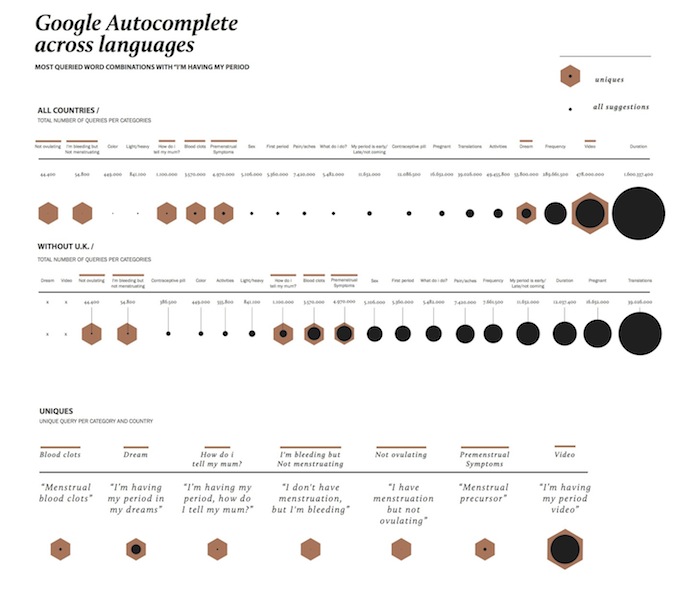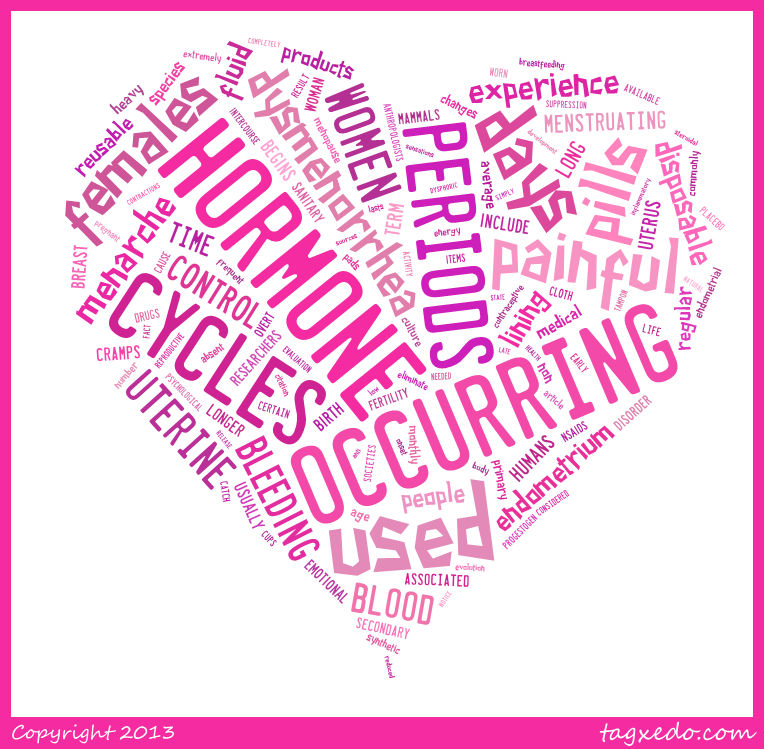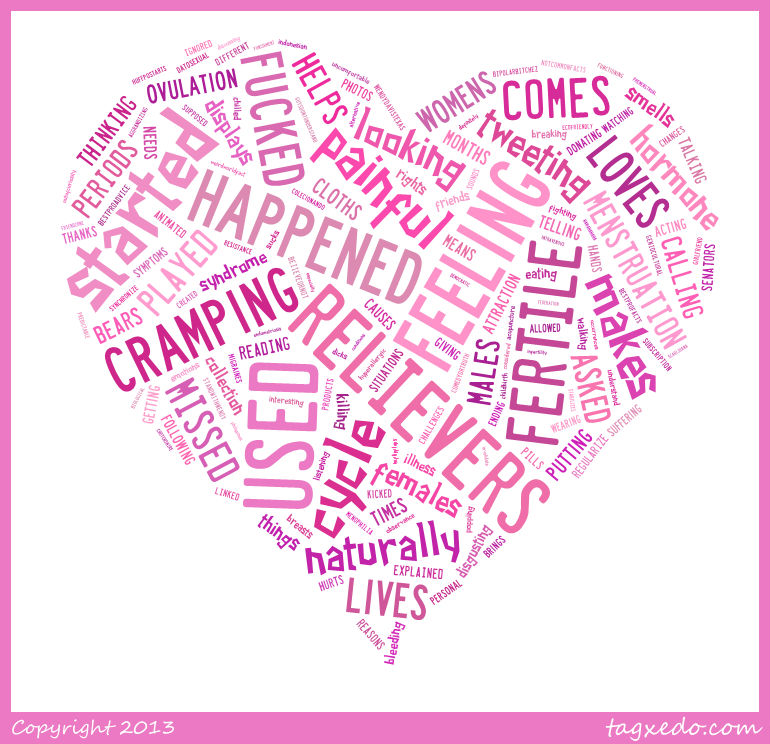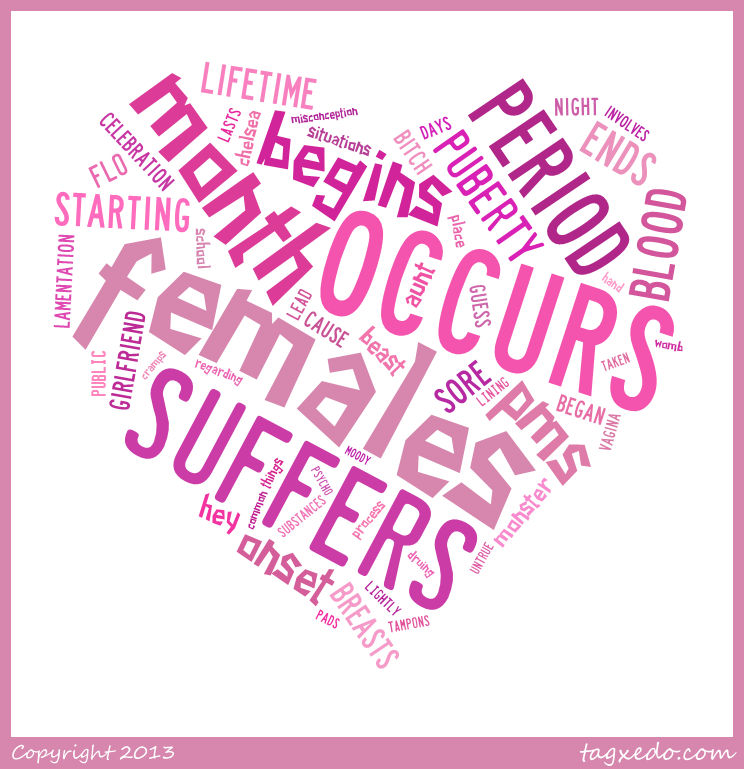You are here: Foswiki>Dmi Web>SummerSchool2013>Dmi2013Projects>MenstruationAcrossCulturesOnline (25 Jul 2013, HanTengLiao)Edit Attach
Menstruation across cultures online
Participants: Astrid Bigoni, Loes Bogers, Zuzana Karascakova, Emily Stacey and Sarah McMonagle This project aims to unravel and understand how menstruation is described and discussed across different languages, platforms and cultures online.In many respects, menstruation is still a taboo in Western societies. Women are encouraged to hide their menstruation and not talk about it in public (Ussher, Jane, 2005, Managing the monstrous feminine). In the public sphere there seem to be two dominant approaches and discourses surrounding menstruation. One is a pathological perspective, which frames menstruation as something that needs medication; either in order for women to cope with their menstruation, or for women to get rid of their menstruation all together. The other sees menstruation as a hygiene problem that needs to be fixed. We aim to reveal the extent to which these constructed discourses are replicated and/or challenged across different cultures, languages and platforms online. We used different DMI tools: Text Ripper, Raw Text to Tag Cloud, Google Auto Complete and Wikipedia Cross-Lingual Image Analysis.
Findings
In some aspects we came to the old conclusion, that we to some extent replicate old patterns of conversation on the internet. This is especially true when we look at what kinds of discourses take place in different spheres.We divided our research into three overlapping spheres:
- A private sphere. This is the health forums where women talk freely among other women. This is a space of problem solving, where women ask and answer questions related to problem-related issues.
- A colloquial sphere. In some cases the language is vulgar and crude (Urban Dictionary & Twitter), but it can also personal, pragmatic and empathic (Google Autocomplete, Women’s health).
- A clinical sphere represented by Wikipedia and NHS.
Findings: Crosslingual comparison based on Wikipedia and Google autocomplete
- A visualisation of the Wikipedia related images on menstruation articles across different language editions:

- Google autocomplete across languages - the most queried word combinations with "I'm having my period":

Findings: Cross-platform comparison
A comparison of tag cloud visualization, showing the most frequent words across three different online platforms:| on English Wikipedia's | on Urban Dictionary's | on Twitter |
|---|---|---|
| "Menstruation" article | "Menstruation" article | |
 |
 |
 |
| I | Attachment | Action | Size | Date | Who | Comment |
|---|---|---|---|---|---|---|
| |
Final_Presentation.pdf | manage | 1 MB | 12 Jul 2013 - 07:37 | AstridBigoni | Our presentation for the summer school |
| |
TOTAL.jpg | manage | 68 K | 12 Jul 2013 - 09:08 | AstridBigoni | Google Auto Complete across languages - the most queried word combinations with "I'm having my period" |
| |
TwitterContentTagCloudFinal.jpg | manage | 160 K | 12 Jul 2013 - 10:10 | AstridBigoni | A tag cloud of the most frequent words used with menstruation on Twitter |
| |
Urban_Dic_Menstruation_Tag_Cloud_Final.jpg | manage | 130 K | 12 Jul 2013 - 10:13 | AstridBigoni | A tag cloud of the most frequent words used with menstruation on Urban Dictionary |
| |
Wikipedia_Menstruation_Tag_Cloud_Final.jpg | manage | 172 K | 12 Jul 2013 - 09:11 | AstridBigoni | A tag cloud of the most frequent words on the English Menstruation article on Wikipedia |
| |
wikirelatedwork.jpg | manage | 767 K | 12 Jul 2013 - 08:53 | AstridBigoni | A visualisation of the Wikipedia related images on menstruation articles across different language editions |
Edit | Attach | Print version | History: r3 < r2 < r1 | Backlinks | View wiki text | Edit wiki text | More topic actions
Topic revision: r3 - 25 Jul 2013, HanTengLiao
 Copyright © by the contributing authors. All material on this collaboration platform is the property of the contributing authors.
Copyright © by the contributing authors. All material on this collaboration platform is the property of the contributing authors. Ideas, requests, problems regarding Foswiki? Send feedback


